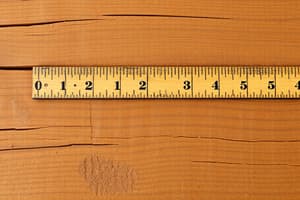Podcast
Questions and Answers
What unit of measurement was commonly used in the Mesopotamian system for weight?
What unit of measurement was commonly used in the Mesopotamian system for weight?
- Pound
- Shekel (correct)
- Cubits
- Inch
Which measurement system was developed during the French Revolution?
Which measurement system was developed during the French Revolution?
- Metric System (correct)
- Roman System
- Imperial System
- Ancient Egyptian System
Which civilization's measurement system included the cubit, often based on the Pharaoh's dimensions?
Which civilization's measurement system included the cubit, often based on the Pharaoh's dimensions?
- Mesopotamian
- Chinese
- Egyptian (correct)
- Roman
What base system did the Mesopotamians primarily use for their measurements?
What base system did the Mesopotamians primarily use for their measurements?
Which measurement units became more common during the Medieval period in England?
Which measurement units became more common during the Medieval period in England?
Which system primarily influenced modern Western measurement methods?
Which system primarily influenced modern Western measurement methods?
What was a significant advantage of the metric system over earlier measurement systems?
What was a significant advantage of the metric system over earlier measurement systems?
What was a primary reason for countries transitioning to the metric system?
What was a primary reason for countries transitioning to the metric system?
Flashcards are hidden until you start studying
Study Notes
Historical Measurement Systems
-
Ancient Civilizations:
- Measurement systems were often based on human anatomy or natural objects.
- Examples include the cubit (based on the forearm) and the foot (based on the size of a human foot).
-
Egyptian System:
- Used royal cubits and were often standardized based on the Pharaoh's measurements.
- Commonly used for building structures like the pyramids.
-
Mesopotamian System:
- Employed base-60 (sexagesimal) system leading to 60 minutes in an hour and 360 degrees in a circle.
- Units included the shekel (weight) and the talent (mass).
-
Roman System:
- Developed a system that influenced modern Western measurements.
- Units included the foot (12 inches), mile (1,000 paces), and various weights based on the libra.
-
Chinese System:
- Utilized a system based on the chi (foot) and the li (distance).
- Measurement units were standardized during the Qin dynasty.
-
Medieval Measurement:
- Localized systems predominated, varying widely between regions.
- Units like the yard, furlong, and acre became more common in England.
-
Metric System:
- Developed during the French Revolution in the late 18th century.
- Introduced standardized units: meter (length), liter (volume), and gram (mass).
- Aimed for universality and ease of conversion, based on powers of ten.
-
Imperial System:
- Established in the British Empire and used in several countries.
- Includes units like inch, foot, yard, mile, ounce, pound, and gallon.
-
Transition to Modern Systems:
- Many countries have transitioned to the metric system for scientific and international use.
- The adoption of the metric system has facilitated global trade and communication.
-
Key Takeaways:
- Measurement systems evolve based on societal needs, trade, and technology.
- Historical systems laid the groundwork for contemporary measurement standards.
Ancient Civilizations
- Measurement systems were often based on human anatomy or natural objects.
- The cubit originated from the length of the forearm, while the foot was modeled on the size of a human foot.
Egyptian System
- Royal cubits were standardized according to the measurements of the Pharaoh, ensuring consistency.
- This system was crucial for constructing monumental structures such as the pyramids.
Mesopotamian System
- Utilized a base-60 (sexagesimal) approach, resulting in 60 minutes per hour and 360 degrees in a circle.
- Key measurement units included the shekel for weight and the talent for mass.
Roman System
- Developed measurement units that significantly influenced modern Western systems.
- Defined common measurements like the foot (12 inches) and the mile (1,000 paces), alongside various weights derived from the libra.
Chinese System
- Based on the chi (foot) and the li (distance), diverging from other ancient systems.
- Standardization of measurement units occurred during the Qin dynasty, enhancing consistency.
Medieval Measurement
- Characterized by localized systems that varied considerably across regions.
- Units like the yard, furlong, and acre gained traction in England during this period.
Metric System
- Established during the French Revolution in the late 18th century as a response to the need for standardized measurements.
- Introduced core units such as the meter for length, liter for volume, and gram for mass, aimed at universality and simplicity in conversions via powers of ten.
Imperial System
- Created within the British Empire and remains in use in various countries.
- Features traditional units including inch, foot, yard, mile, ounce, pound, and gallon.
Transition to Modern Systems
- A shift towards the metric system has been seen in many countries to facilitate scientific and international applications.
- Adoption of the metric system supports global trade and enhances communication efficiency.
Key Takeaways
- Historical measurement systems have evolved in response to societal demands, trade necessities, and technological advancements.
- The foundations laid by ancient systems contribute to contemporary measurement standards.
Studying That Suits You
Use AI to generate personalized quizzes and flashcards to suit your learning preferences.




